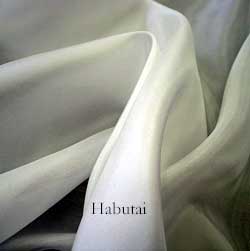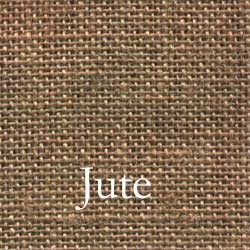TEXTILE DICTIONARY AND TERMS RELATING TO TEXTILE
H-I-J-K
Habutae or habutai (pr. ha-bu-ti). Japanese meaning "soft as down". Light-weight Japanese silk originally woven, on hand looms, of silk in the gum, afterward boiled off.
Similar to China silk, but heavier and more durable. Sold by momme weight. White or dyed. Washes and wears well. Uses: undergarments, blouses, shirts, draperies, lamp shades. Weave—plain. Width, 27", 30", 36". Hair cloth. Stiff, wiry fabric made of cotton, worsted or linen warp (usually cotton) and filling of horsehair. Fabric as wide as the length of a hair (horse's mane). One pick of the filling formed by a single hair. Black, white or gray. Uses: stiffening interlining, upholstering. Weave—plain or twill (herringbone). Width, 15", 18", 30".

Hair line stripe. Men's or women's suiting in black or dark blue with stripe of a single white warp yarn.
Half-linen:Cotton warp and linen weft: resistance, delicacy and wonderful handle.
Hammock Crash: This cloth, as the name implies, is used in the making of hammocks. It is ma.de strong and durable to stand the strain and wear that it is subjected to and can be woven on almost any or dinary loom
Handkerchief linen. Linen lawn used for women's handkerchiefs. Also for lingerie, infants' wear and neckwear. White, colored and barred.
Hardanger cloth. Soft, mercerized cotton cloth of basket weave similar in appearance to Oxford suiting. Used for Norwegian needlework called Hardanger embroidery. White and ecru. Weave—basket. Width, 40".
Harness. Warp, treadles and tie-up of treadles on loom.
Hatter's plush. Silk plush with long, scanty pile which is pressed flat or panned. Uses: millinery. Width, 21", 40".
Heddle. Device on a loom which controls the opening of space between warp yarns to receive the filling.
Heatherbloom. Trade named fabric similar to percaline. Name stamped on selvage. Found now only in ready to wear garments.
Heather mixture. Any combination of colored wool fibres blended in yarns for knit goods and tweeds. Originally suggested color of heather field in Scotland.
Hemp.
Fibres obtained from stalk of hemp plant used chiefly in ropes and cordage.
Henrietta. Named in honor of Henrietta Marie, French Queen of England in 1624, wife of Charles I. Light-weight dress fabric similar to cashmere. Originally made with silk warp mostly in black. It differs from cashmere only in fineness and finish, being more lustrous. Uses: same as cashmere. Weave—'twill. Width, 36", 42", 44".
Herringbone twill. Zigzag effect produced by alternating the direction of the twill. Resembles the backbone of a herring.
Hickory shirting. Heavy twilled striped cotton shirting. Resembles ticking, lighter weight, softer feel. Similar to cottonade which is used for trousering. Yarn-dyed. Blue, or brown and white. Weave—twill. Width, 28".
Holland Shade cloth. Plain woven linen, finished with a sizing of oil and starch which renders it opaque. Most shade cloth now made of fine cotton and finished to look like linen. Uses: window shades, lamp shades.
Homespun. Loose, rough woolen fabric of coarse wool fibres. Formerly made on hand looms at home from hand spun yarns. Now imitated by machine. Revived from time to time. Fabric resembles a tweed in general character. Uses: sports clothing and men's suits. Weave—plain or twill. Width, 54".
Honeycomb. Name of weave used in toweling and occasionally for cotton or wool suiting. Marked ridges and hollows suggest surface of a honeycomb. Desirable in toweling because it exposes more surface for absorption than a plain weave. One variety of this weave, called " wafilecloth "

.
Hospital Gauze. See Cheesecloth.
Huck or Huckaback. Word derived from huckster and back, The huckster in England was a man who carried his wares on his back. Toweling of linen, cotton or union having a small design, recognized as huck. Often woven in towel lengths with border on either end. Colored designs or name of hotel or firm may be woven in. Half bleached or white. Wears well and is very absorbent. Weave—figure. Width, 15", 16", 18", 20", 22", 24".
Hygroscopic or moisture-retaining property. Common to silk and wool. Wool retains the greatest percentage of moisture without appearing to be wet. This accounts for the added weight in overcoats worn in damp weather, Hence the need for the cravenette process.
Illusion. Term used for tulle or maline. Refers to very thin, transparent, silk net. See Tulle and Maline.
Indian Head.*
Trade marked cotton fabric, first made heavy and coarse like Butcher's linen. Modern permanent finish makes a smoother, lighter weight cloth suited to a variety of purposes. Name stamped on selvage. Unbleached, white and colored. Latter has guaranteed dye. Similar materials in white bear other tradenames. Uses: uniforms, aprons, napkins, tablecloths, towels, shirts, bibs, children's play clothes, middies, and many household uses, colors for suiting and curtains. Weave—plain. Width, white, 36", 54", 63"; colors, 36".
India linon. French for lawn. Fine, closely woven, white cotton fabric; fairly crisp finish. Launders well. Uses: waists, dresses, lingerie, linings. Weave—plain. Width, 27", 32", 36", 45"-
Ingrain. 1. See dyeing. 2, Kind of carpet, seldom seen now, woven flat, Jacquard design, reversible. Cotton and wool or all wool.
In the grease. Wool as it leaves the sheep's back before scouring.
In the gray. Unbleached or undyed cotton or linen cloth.
In the gum. Silk in its raw or natural state, before degum-ming. It contains sericin or silk gum which makes it stiff and dull.
Italian silk.* Trade name for warp knit fabric used in gloves, and undergarments.
Jacquard (Fr. pr. zha-kar, English pr. jak-ard). 1. Damasks, tapestries, brocades and all cloths with elaborate figures require the Jacquard loom. The most complicated picture may be reproduced in Jacquard weaving. 2. Knit fabrics with novelty pattern in stitch or colors, as fancy golf hose.
Japanese crepe. See Crepe.
Japanese silk. See Habuta?.
Java Canvas. See Ada Canvas.
Jean. Heavy, twilled cotton fabric like drilling only a little finer and bleached; also called middy twill. White, plain colors or stripes. Duretta*, a trade name for Jean. Uses: heavy grades, suitings and corsets; lighter grades, linings, underwear, children's clothes. Weave—twill. Width, 36".
Jersey. I. Plain knitting, not ribbed. 2. Jersey cloth usually wool. May be silk, cotton or rayon. Cotton Jersey is called stockinette. Wool Jersey may be smooth or napped; light weight fabric tends to stretch and sag. Uses: dresses, coats, suits. Knitted in tubular form any width. 3. Jersey silk. See Milanese.
Jusi (pr. hoo-see). Delicate fabric for dresses made in the Philippine Islands either from pure silk (in the gum) or silk with abaca or pineapple fibre. The yarns (of vegetable fibres) are tied end to end instead of being spun.
Jute. Coarse, brown fibre obtained from the stalk of a plant in India. Used in burlap, cordage and the backing for low grade rugs and carpets.

Kapock Trade name for fast color drapery fabrics.
Kapok. Soft, light fibres from seed pod of a tree in East and West Indies. Called "silk floss". Uses: mattresses, pillows, life preservers.
Kasha*. Type of flannel dress goods introduced by Rodier Freres, Paris, who claim exclusive right to name. Similar cloths, bearing various trade names, made by American manufacturers. Weave—twill. Width, 54".
Kemp. Dead or diseased wool fibres which do not take the dye are called "kempy wool".
Kersey. Thick woolen cloth similar to melton but finished differently. May contain cotton warp with wool filling or have cotton mixed with wool in yarn. Felted, napped and polished. Much like a heavy broadcloth, shorter nap. Uses: uniforms, overcoats. Weave—twill. Width, 54".
Khaki (pr. kah-ky). I. East Indian word meaning earth color. O. D. or olive drab color used for U. S. army uniforms. 2. Cotton twill uniform cloth in khaki color. Uses: scout uniforms, outing suits, work clothes, children's play clothes. Weave—twill. Width, 28".
Khaki Kool.* Trade name for a sports silk of rough, crepy texture.
Kiddie Kloth* See Gingham.
Kidderminster. An ingrain carpet first made at Kidderminster, England.
Kimono Crepe. See Crepe.
Kimono flannel. Soft, napped cotton fabric usually printed,
nap on one side only. Also called flannelette. Uses:
kimonos and dressing sacques. Weave—plain.
Kimono silk. Light-weight printed spun silk. Uses: kimonos,
linings, curtains. Weave—plain or satin. Width, 32". Kindergarten cloth.* See Gingham. Klearflax* Trade name for rugs made entirely of linen fibres,
American product. Knit. Not woven of warp and filling but produced by interlacing of loops. Kobe flannel. Japanese challis. See Challis. Ladies cloth. Obsolete. Light ..eight broadcloth or flannel with nap.
